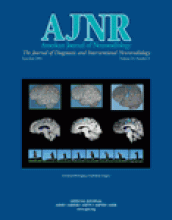Treatment of atherosclerotic disease of the extracranial carotid arteries in a patient with an advanced degree of stenosis substantially reduces the risk of subsequent neurologic event. Whether surgical endarterectomy or endovascular stent placement proves to be the more effective treatment of the narrowed carotid artery has yet to be shown. In any event, accurate assessment of the degree of luminal narrowing is an important step in treatment planning.
Rapid advances in imaging hardware, in turn, permit modifications in image acquisition techniques. However, one cannot take for granted that new methods necessarily provide more accurate results, and frequent reevaluation of which methods are most efficacious is appropriate and necessary. This is of particular relevance to the development and wide use of contrast-enhanced MR angiography methods for evaluation of the carotid arteries. In this month’s issue of the AJNR, Borisch et al report on whether a strategy of combining the results from contrast-enhanced MR angiography with those from color-coded duplex sonography can reduce the need for digital subtraction angiography, a catheter-based diagnostic study. The authors paid particular attention to surgical candidates who had stenoses 70% based on digital subtraction angiography. Their results indicated that none of those patients would have been assigned to a lower grade of stenosis based on the noninvasive studies if the sonography and contrast-enhanced MR angiography findings were concordant.
The analysis presented raises a number of interesting questions. Can we rely on concordant findings to accurately evaluate all cases of carotid stenosis greater than a given cutoff point? Is there an implication that the two noninvasive methods used were somehow complementary so that where one fails the other is automatically bound to be correct? Investigation of a larger series of studies with attention paid to possible reasons for the false negatives of each technique could help define the extent to which the results presented in this article reflect an underlying mechanistic reason why concordant data are more reliable than the individual tests. If no underlying physical basis is found, the result could simply reflect that for two methods with high sensitivity, the probability that both measurements from two uncorrelated measurements will provide a false negative is much smaller than the probability that either one of them will.
Any investigation involving multi-technique imaging of the arterial lumen raises the question of how meaningful are the comparisons made between modalities that are sensitive to the luminal area and those that assess the lumen diameter. MR angiography and CT angiography provide images of the lumen in cross section, and Doppler sonography provides velocity measurements that are area-dependent, whereas conventional angiography, the historic “ gold-standard” technique, is generally interpreted in terms of diameter measures. Considerations of digital subtraction angiography must also take into account the evolution of that technique, with rotational digital subtraction angiography now providing a more comprehensive evaluation of the arterial lumen than was available in earlier studies of intermodality correlation. The standard of truth, therefore, continues to be a moving target, complicating the evaluation of new techniques. The question of accuracy standards becomes more pressing as there is an increasing move to replace digital subtraction angiography with noninvasive diagnostic studies. Retaining adequate control of imaging standards in the absence of digital subtraction angiography will be challenging, and reference to independent validation data, such as the endarterectomy specimen, will be necessary to ensure that imaging methods remain reliable and provide patients with the highest quality care possible.
These concerns are perhaps greatest for MR imaging, with which image appearance can vary considerably with small alterations in the detailed implementation of a pulse sequence. We have found in our own studies that contrast-enhanced MR angiography underestimates the caliber of the residual lumen in comparison with measurements made from time-of-flight MR angiography studies. Detailed investigations using flow models have identified several factors that contribute to an underestimation of lumen size, including absence of flow compensation gradients in contrast-enhanced MR angiography; larger voxel size used in contrast-enhanced MR angiography; and, of key importance, contrast-enhanced MR angiography of the extracranial carotid arteries being invariably implemented with the frequency-encoding gradient aligned parallel to the primary flow direction, which results in flow-related signal intensity loss. Still, in several areas, contrast-enhanced MR angiography possesses powerful advantages relative to time-of-flight MR angiography, and the optimal use of these different MR angiography methods must still be defined.
The new cross-sectional capabilities of MR angiography and the ability of MR imaging to probe the composition and geometry of the vessel wall herald a new era during which the radiologist will be asked to assess the vessel wall in addition to the lumen. Those capabilities should provide new opportunities for determining those image characteristics of the advanced atherosclerotic lesion that more comprehensively capture the complex nature of disease at the bifurcation and more fully identify the true determinants of future neurologic risk. No matter how alluring the new methods might appear, they will require, as in the case of contrast-enhanced MR angiography reported herein, careful evaluation against accepted standards.
- Copyright © American Society of Neuroradiology












